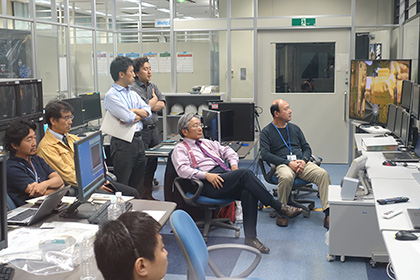This is an archive of information released in the past.
Disclaimer: It may contain broken links or outdated information. Some parts may not function in current web browsers.
*Visit https://humans-in-space.jaxa.jp/en/ for the latest information.

Experiment
- News
- Kibo Utilization Strategy
- Kibo Utilization Plan
- List of JAXA's Utilization Themes
- Experiment Facilities
- Space Environment Utilization
- Archive
First experiment using the Exposed Experiment Handrail Attachment Mechanism (ExHAM) started

Airlock's slide table being extended to the EF (Credit: JAXA/NASA)

ExHAM being attached to the handrail on the EF (Credit: JAXA/NASA)
On May 26, 2015, the first experiment using JAXA's new experiment device, the Experiment Handrail Attachment Mechanism (ExHAM) started.
ExHAM is a device that enables researchers to conduct space exposed experiments. Experimental samples can be placed onto the surfaces of the ExHAM. Then the ExHAM with samples is attached to a handrail of the Kibo's Exposed Facility (EF) to expose the samples into space.
From evening till night on May 26, ExHAM with the attached samples was taken out to the EF and grappled by the Kibo's robotic arm, Japanese Experiment Module Remote Manipulator System Small Fine Arm (JEMRMS SFA). Then it was attached to the handrail on the EF.
The first experiment themes started this time are as follows. The samples were delivered aboard the SpaceX CRS-6 this April.
- Astrobiology Exposure and Micrometeoroid Capture Experiments (TANPOPO)
- Space Environment Exposure Experiment of Carbon Nanotube Material for Space Application (CNT)
- Quest for the Compositional identification and Chemical evolutional understanding of the Interstellar Dust (QCC)
- Material Degradation Monitor on ExHAM (MDM2)
- Space Environmental Testing of PEEK and PFA sample (PEEK)
- On-orbit demonstration of target marker for space robotics (ArrayMark)
At the User Operation Area (UOA) in the Tsukuba Space Center (TKSC), concerned people as represented by Principal Investigators (PI) Dr. Yoji Ishikawa of Obayashi Corporation and Dr. Itsuki Sakon of the University of Tokyo had gathered and monitored the ExHAM installation.

Concerned people including PIs and Co-Investigators monitor ExHAM installation (Credit: JAXA)
Opportunities to install such exposed experiment devices on the exterior of the ISS had previously been limited because it necessitated Extravehicular Activities (EVAs) by the onboard crew. By utilizing Kibo's airlock and robotic arm function, the opportunities to perform outboard experiments will be increased without performing EVAs.
 Movie 1: ExHAM being taken out to the EF and then grappled by the Kibo's robotic arm. [WMV: 1m11s, no sound]
Movie 1: ExHAM being taken out to the EF and then grappled by the Kibo's robotic arm. [WMV: 1m11s, no sound] Movie 2: ExHAM being transferred from the slide table and attached to the handrail. [WMV: 2m15s, no sound]
Movie 2: ExHAM being transferred from the slide table and attached to the handrail. [WMV: 2m15s, no sound]
*All times are Japan Standard Time (JST)
| Copyright 2007 Japan Aerospace Exploration Agency | Site Policy |
